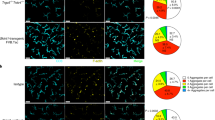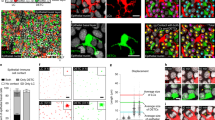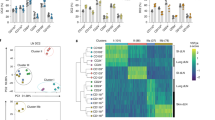Abstract
During adaptive immune responses, dendritic cells activate T cells and endow them with specific homing properties. Mechanisms that 'imprint' specific tropisms, however, are not well defined. We show here that 1,25(OH)2D3, the active form of vitamin D3, signaled T cells to express CC chemokine receptor 10, which enabled them to migrate to the skin-specific chemokine CCL27 secreted by keratinocytes of the epidermis. In contrast, 1,25(OH)2D3 suppressed the gut-homing receptors α4β7 and CCR9. Vitamin D3, the inactive prohormone naturally generated in the skin by exposure to the sun, was processed by dendritic cells and T cells to the active metabolite, providing a mechanism for the local regulation of T cell 'epidermotropism'. Our findings support a model in which dendritic cells process and 'interpret' locally produced metabolites to 'program' T cell homing and microenvironmental positioning.
This is a preview of subscription content, access via your institution
Access options
Subscribe to this journal
Receive 12 print issues and online access
$209.00 per year
only $17.42 per issue
Buy this article
- Purchase on Springer Link
- Instant access to full article PDF
Prices may be subject to local taxes which are calculated during checkout






Similar content being viewed by others
Accession codes
References
Kunkel, E.J. & Butcher, E.C. Chemokines and the tissue-specific migration of lymphocytes. Immunity 16, 1–4 (2002).
Morales, J. et al. CTACK, a skin-associated chemokine that preferentially attracts skin-homing memory T cells. Proc. Natl. Acad. Sci. USA 96, 14470–14475 (1999).
Homey, B. et al. CCL27–CCR10 interactions regulate T cell–mediated skin inflammation. Nat. Med. 8, 157–165 (2002).
Reiss, Y., Proudfoot, A.E., Power, C.A., Campbell, J.J. & Butcher, E.C. CC chemokine receptor (CCR)4 and the CCR10 ligand cutaneous T cell-attracting chemokine (CTACK) in lymphocyte trafficking to inflamed skin. J. Exp. Med. 194, 1541–1547 (2001).
MacLaughlin, J.A., Anderson, R.R. & Holick, M.F. Spectral character of sunlight modulates photosynthesis of previtamin D3 and its photoisomers in human skin. Science 216, 1001–1003 (1982).
Webb, A.R. & Holick, M.F. The role of sunlight in the cutaneous production of vitamin D3. Annu. Rev. Nutr. 8, 375–399 (1988).
Holick, M.F. et al. Photosynthesis of previtamin D3 in human skin and the physiologic consequences. Science 210, 203–205 (1980).
Haddad, J.G., Matsuoka, L.Y., Hollis, B.W., Hu, Y.Z. & Wortsman, J. Human plasma transport of vitamin D after its endogenous synthesis. J. Clin. Invest. 91, 2552–2555 (1993).
Prosser, D.E. & Jones, G. Enzymes involved in the activation and inactivation of vitamin D. Trends Biochem. Sci. 29, 664–673 (2004).
van Etten, E. & Mathieu, C. Immunoregulation by 1,25-dihydroxyvitamin D3: Basic concepts. J. Steroid Biochem. Mol. Biol. 97, 93–101 (2005).
Liu, P.T. et al. Toll-like receptor triggering of a vitamin D-mediated human antimicrobial response. Science 311, 1770–1773 (2006).
Cantorna, M.T. & Mahon, B.D. D-hormone and the immune system. J. Rheumatol. Suppl. 76, 11–20 (2005).
Mangelsdorf, D.J. & Evans, R.M. The RXR heterodimers and orphan receptors. Cell 83, 841–850 (1995).
Mora, J.R. et al. Selective imprinting of gut-homing T cells by Peyer's patch dendritic cells. Nature 424, 88–93 (2003).
Iwata, M. et al. Retinoic acid imprints gut-homing specificity on T cells. Immunity 21, 527–538 (2004).
Stagg, A.J., Kamm, M.A. & Knight, S.C. Intestinal dendritic cells increase T cell expression of α4β7 integrin. Eur. J. Immunol. 32, 1445–1454 (2002).
Soler, D., Humphreys, T.L., Spinola, S.M. & Campbell, J.J. CCR4 versus CCR10 in human cutaneous TH lymphocyte trafficking. Blood 101, 1677–1682 (2003).
Kang, K. et al. IL-12 synthesis by human Langerhans cells. J. Immunol. 156, 1402–1407 (1996).
Muller, G. et al. Identification and induction of human keratinocyte-derived IL-12. J. Clin. Invest. 94, 1799–1805 (1994).
Vieth, R. Vitamin D supplementation, 25-hydroxyvitamin D concentrations, and safety. Am. J. Clin. Nutr. 69, 842–856 (1999).
Rottman, J.B., Smith, T.L., Ganley, K.G., Kikuchi, T. & Krueger, J.G. Potential role of the chemokine receptors CXCR3, CCR4, and the integrin αEβ7 in the pathogenesis of psoriasis vulgaris. Lab. Invest. 81, 335–347 (2001).
Picker, L.J., Michie, S.A., Rott, L.S. & Butcher, E.C. A unique phenotype of skin-associated lymphocytes in humans. Preferential expression of the HECA-452 epitope by benign and malignant T cells at cutaneous sites. Am. J. Pathol. 136, 1053–1068 (1990).
Berg, E.L. et al. The cutaneous lymphocyte antigen is a skin lymphocyte homing receptor for the vascular lectin endothelial cell-leukocyte adhesion molecule 1. J. Exp. Med. 174, 1461–1466 (1991).
Hudak, S. et al. Immune surveillance and effector functions of CCR10+ skin homing T cells. J. Immunol. 169, 1189–1196 (2002).
Ohyama, Y. et al. Identification of a vitamin D-responsive element in the 5′-flanking region of the rat 25-hydroxyvitamin D3 24-hydroxylase gene. J. Biol. Chem. 269, 10545–10550 (1994).
Lomri, A. & Baron, R. 1α,25-Dihydroxyvitamin D3 regulates the transcription of carbonic anhydrase II mRNA in avian myelomonocytes. Proc. Natl. Acad. Sci. USA 89, 4688–4692 (1992).
Quelo, I., Machuca, I. & Jurdic, P. Identification of a vitamin D response element in the proximal promoter of the chicken carbonic anhydrase II gene. J. Biol. Chem. 273, 10638–10646 (1998).
Kupper, T.S. & Fuhlbrigge, R.C. Immune surveillance in the skin: mechanisms and clinical consequences. Nat. Rev. Immunol. 4, 211–222 (2004).
Sallusto, F. Origin and migratory properties of dendritic cells in the skin. Curr. Opin. Allergy Clin. Immunol. 1, 441–448 (2001).
Mora, J.R. et al. Reciprocal and dynamic control of CD8 T cell homing by dendritic cells from skin- and gut-associated lymphoid tissues. J. Exp. Med. 201, 303–316 (2005).
Guo, Y., Strugnell, S., Back, D.W. & Jones, G. Transfected human liver cytochrome P-450 hydroxylates vitamin D analogs at different side-chain positions. Proc. Natl. Acad. Sci. USA 90, 8668–8672 (1993).
Pan, J. et al. A novel chemokine ligand for CCR10 and CCR3 expressed by epithelial cells in mucosal tissues. J. Immunol. 165, 2943–2949 (2000).
Nemanic, M.K. et al. In vitro synthesis of vitamin D3 by cultured human keratinocytes and fibroblasts: action spectrum and effect of AY-9944. Biochim. Biophys. Acta 841, 267–277 (1985).
Stoffels, K. et al. Immune regulation of 25-hydroxyvitamin-D3-1α-hydroxylase in human monocytes. J. Bone Miner. Res. 21, 37–47 (2006).
Fritsche, J., Mondal, K., Ehrnsperger, A., Andreesen, R. & Kreutz, M. Regulation of 25-hydroxyvitamin D3-1α-hydroxylase and production of 1α,25-dihydroxyvitamin D3 by human dendritic cells. Blood 102, 3314–3316 (2003).
Campbell, J.J. et al. The chemokine receptor CCR4 in vascular recognition by cutaneous but not intestinal memory T cells. Nature 400, 776–780 (1999).
Homey, B. et al. Up-regulation of macrophage inflammatory protein-3α/CCL20 and CC chemokine receptor 6 in psoriasis. J. Immunol. 164, 6621–6632 (2000).
Gombert, M. et al. CCL1–CCR8 interactions: an axis mediating the recruitment of T cells and Langerhans-type dendritic cells to sites of atopic skin inflammation. J. Immunol. 174, 5082–5091 (2005).
Clark, R.A. et al. The vast majority of CLA+ T cells are resident in normal skin. J. Immunol. 176, 4431–4439 (2006).
Schaerli, P. et al. A skin-selective homing mechanism for human immune surveillance T cells. J. Exp. Med. 199, 1265–1275 (2004).
Kunkel, E.J. et al. CCR10 expression is a common feature of circulating and mucosal epithelial tissue IgA Ab-secreting cells. J. Clin. Invest. 111, 1001–1010 (2003).
Leung, D.Y. et al. Bacterial superantigens induce T cell expression of the skin-selective homing receptor, the cutaneous lymphocyte-associated antigen, via stimulation of interleukin 12 production. J. Exp. Med. 181, 747–753 (1995).
Sigmundsdottir, H., Johnston, A., Gudjonsson, J.E. & Valdimarsson, H. Differential effects of interleukin 12 and interleukin 10 on superantigen-induced expression of cutaneous lymphocyte-associated antigen (CLA) and αEβ7 integrin (CD103) by CD8+ T cells. Clin. Immunol. 111, 119–125 (2004).
Piemonti, L. et al. Vitamin D3 affects differentiation, maturation, and function of human monocyte-derived dendritic cells. J. Immunol. 164, 4443–4451 (2000).
Penna, G. & Adorini, L. 1α,25-dihydroxyvitamin D3 inhibits differentiation, maturation, activation, and survival of dendritic cells leading to impaired alloreactive T cell activation. J. Immunol. 164, 2405–2411 (2000).
Griffin, M.D. et al. Dendritic cell modulation by 1α,25 dihydroxyvitamin D3 and its analogs: a vitamin D receptor-dependent pathway that promotes a persistent state of immaturity in vitro and in vivo. Proc. Natl. Acad. Sci. USA 98, 6800–6805 (2001).
Boonstra, A. et al. 1α,25-dihydroxyvitamin D3 has a direct effect on naive CD4+ T cells to enhance the development of Th2 cells. J. Immunol. 167, 4974–4980 (2001).
Iwata, M., Eshima, Y. & Kagechika, H. Retinoic acids exert direct effects on T cells to suppress Th1 development and enhance Th2 development via retinoic acid receptors. Int. Immunol. 15, 1017–1025 (2003).
Cantorna, M.T., Zhu, Y., Froicu, M. & Wittke, A. Vitamin D status, 1,25-dihydroxyvitamin D3, and the immune system. Am. J. Clin. Nutr. 80, 1717S–1720S (2004).
Mathieu, C. et al. In vitro and in vivo analysis of the immune system of vitamin D receptor knockout mice. J. Bone Miner. Res. 16, 2057–2065 (2001).
Carpenter, K.J. & Zhao, L. Forgotten mysteries in the early history of vitamin D. J. Nutr. 129, 923–927 (1999).
Lehmann, B., Rudolph, T., Pietzsch, J. & Meurer, M. Conversion of vitamin D3 to 1α,25-dihydroxyvitamin D3 in human skin equivalents. Exp. Dermatol. 9, 97–103 (2000).
Lehmann, B., Genehr, T., Knuschke, P., Pietzsch, J. & Meurer, M. UVB-induced conversion of 7-dehydrocholesterol to 1α,25-dihydroxyvitamin D3 in an in vitro human skin equivalent model. J. Invest. Dermatol. 117, 1179–1185 (2001).
Harris, S.S. & Dawson-Hughes, B. Plasma vitamin D and 25OHD responses of young and old men to supplementation with vitamin D3. J. Am. Coll. Nutr. 21, 357–362 (2002).
Platz, E.A. et al. Plasma 1,25-dihydroxy- and 25-hydroxyvitamin D and adenomatous polyps of the distal colorectum. Cancer Epidemiol. Biomarkers Prev. 9, 1059–1065 (2000).
Eksteen, B. et al. Epithelial inflammation is associated with CCL28 production and the recruitment of regulatory T cells expressing CCR10. J. Immunol. 177, 593–603 (2006).
Gupta, V.K., McConnell, I. & Hopkins, J. Reactivity of the CD11/CD18 workshop monoclonal antibodies in the sheep. Vet. Immunol. Immunopathol. 39, 93–102 (1993).
Young, A.J., Hein, W.R. & Hay, J.B. Manual of Immunological Methods: the Comprehensive Source Book of Techniques 2039–2059 (Academic Press, San Diego, 1997).
Issekutz, T.B., Chin, W. & Hay, J.B. Lymphocyte traffic through granulomas: differences in the recovery of indium-111-labeled lymphocytes in afferent and efferent lymph. Cell. Immunol. 54, 79–86 (1980).
Acknowledgements
We acknowledge the University of California Santa Cruz Genome Browser created by the Genome Bioinformatics Group of the University of California Santa Cruz, and thank C. Crumpton-Carswell and L. Rott for flow cytometry assistance; F. Lin for help with graphics; L. Gigliello and J. Hay (University of Toronto) for help with surgical procedures; and A. Chawla for RXR-β protein. Mouse anti–ovine CD11c was provided by A. Young (South Dakota State University). Supported by the National Institutes of Health (E.C.B.; 5 T32 AI07290-21 to H.S.), the Department of Veterans Affairs (E.C.B.), the FACS Core Facility of the Stanford Digestive Disease Center, the Arthritis Foundation (G.F.D.) and the Deutsche Forschungsgemeinschaft (C.A.).
Author information
Authors and Affiliations
Contributions
H.S., J.P. and E.C.B. designed and conceptualized the research; H.S. did the in vitro human experiments; J.P. did the microarray, PCR and gel-shift studies and vitamin D measurements; G.F.D. and C.A. did the sheep experiments; D.S. provided essential CCR9 and CCR10 antibodies; A.H. provided intellectual and experimental input; and H.S. and E.C.B. wrote the paper with assistance from J.P. and input from G.F.D.
Corresponding author
Ethics declarations
Competing interests
D.S. is an employee of Millennium Pharmaceuticals.
Supplementary information
Supplementary Fig. 1
1,25(OH)2D3 but not retinoic acid induces the expression of CCR10 on CD8+ T cells. (PDF 661 kb)
Supplementary Fig. 2
Genomic view of the CCR10 gene. (PDF 84 kb)
Supplementary Fig. 3
Chemokine receptor expression by circulating memory and in vitro activated T cell subsets. (PDF 589 kb)
Supplementary Fig. 4
Schematic summary of the proposed role of sunlight, vitamin D and dendritic cells in the induction of CCR10 on T cells. (PDF 418 kb)
Rights and permissions
About this article
Cite this article
Sigmundsdottir, H., Pan, J., Debes, G. et al. DCs metabolize sunlight-induced vitamin D3 to 'program' T cell attraction to the epidermal chemokine CCL27. Nat Immunol 8, 285–293 (2007). https://doi.org/10.1038/ni1433
Received:
Accepted:
Published:
Issue Date:
DOI: https://doi.org/10.1038/ni1433
This article is cited by
-
Localization, tissue biology and T cell state — implications for cancer immunotherapy
Nature Reviews Immunology (2023)
-
Engineering the lymph node environment promotes antigen-specific efficacy in type 1 diabetes and islet transplantation
Nature Communications (2023)
-
The precursors of CD8+ tissue resident memory T cells: from lymphoid organs to infected tissues
Nature Reviews Immunology (2022)
-
Vitamin D Regulation of Immune Function
Current Osteoporosis Reports (2022)
-
Vitamin D regulation of immune function during covid-19
Reviews in Endocrine and Metabolic Disorders (2022)



